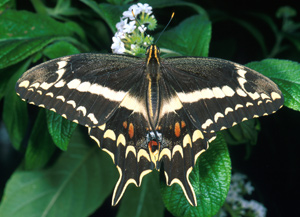Papilio aristodemus ponceanus, Shaus Swallowtail Butterfly |
|---|
 Papilio aristodemus ponceanus, more popularly known as the Schaus swallowtail butterfly, was first described by William Schaus in 1911, when he found the species scattered amongst “tropical hardwood hammocks” ( in layman’s terms – any raised ground covered with trees) ranging from South Miami to Lower Matecumbe Key in the Florida Keys. This butterfly, like all swallowtails, belongs to the family Papilionidae. Adults have black-brown wings with yellow markings, and there is a broad rust-colored area underneath the hind wing at the outer end of the discal cell and a short distance around the sides of the cell (see picture). The Schaus swallowtail can be distinguished from the closely-related giant swallowtail (P. cresphontes) by its smaller size and because its upper forewing submarginal spots are parallel to the margin of the wing. Newly hatched larvae are black-brown with a white thirteenth segment and a light speck on each side of the seventh ring. They change in color and appearance with each instar molt. Mostly they resemble bird droppings. When threatened, a white bifurcated organ protrudes from its nape and exudes a strong odor. Breeding is usually during April to June, when the rainy season causes the emergence of adults to occur. The light green eggs are deposited singly on host plants, and after the third or fifth day, they hatch to become solitary larvae, until they form chrysalises on the twentieth day. The pupal stage can last for a year or two, until synchronized by the rainy season. Adults have a lifespan of approximately one month. Adults have a variety of feeding preferences. Mostly they feed on the nectar from blossoms of guava (Psidium guajava), wild tamarind, and cheese shrub (Morinda royoc). The larvae also aren’t extremely restricted in their feeding habits, which probably makes their reintroduction to the wild seem likely to succeed. The larvae feed on the tender new growth of torchwood (Amyris elemifera) and wildlime (Xanthoxylum fagara). Both of these plants are pioneering shrubs in whose shade sprout hardwood seedlings which eventually form the hammock. Biologists believe that the butterflys’ decline in numbers and range was due largely to habitat loss, aerial application of insecticides, and over-collecting. P.ponceanus was one of the first insects protected under the Endangered Species Act (ESA). It is also one of the rarest. In 1984, this South Florida subspecies was on the brink of extinction due to habitat loss. Since then, awareness and recent release of captive-bred butterflies into protected wilds, maintenance of existing colonies and acquiring land for newly discovered populations, have made recovery seem hopeful. The involvement of the University of Florida, Florida Department of Environmental Protection, and other crucial agencies have helped ensure that this beautiful creature now has a protected habitat, a relatively pesticide-free environment, and a larger population in the wild. |
Resources: |
Written by: Marisa Sweetser, Spring 2004 |
Image credit: Thomas C. Emmel |